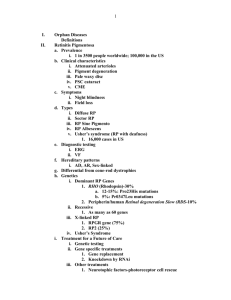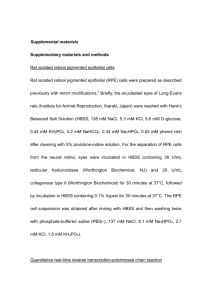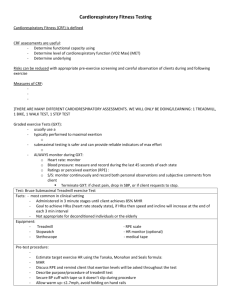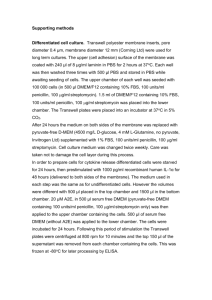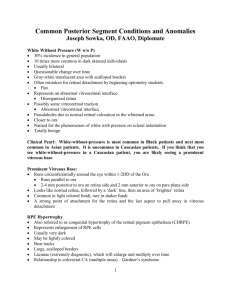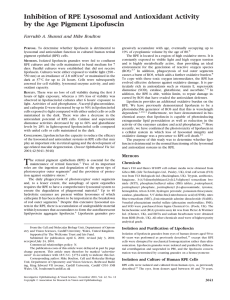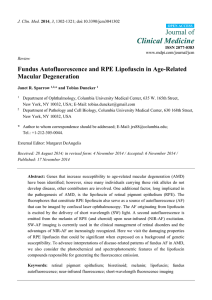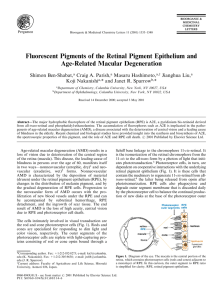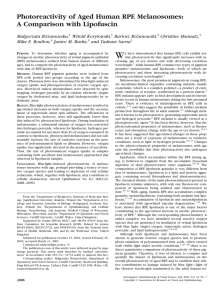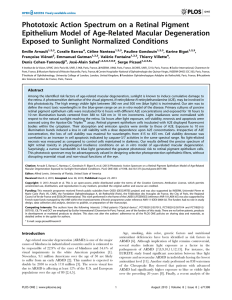Light Exposure, Lipofuscin and AMD Implications in Optometric Training and Clinical Practice
advertisement
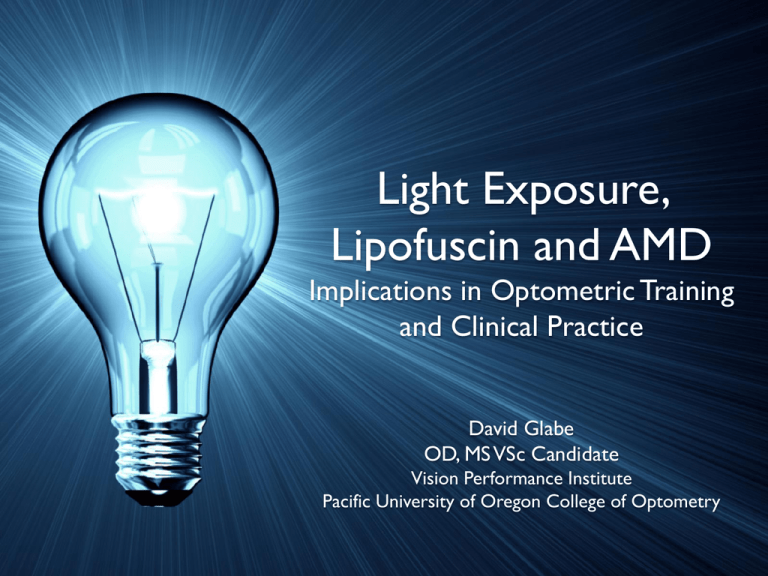
Light Exposure, Lipofuscin and AMD Implications in Optometric Training and Clinical Practice David Glabe OD, MS VSc Candidate Vision Performance Institute Pacific University of Oregon College of Optometry How are the following items related? RPE lipofuscin Light exposure Antioxidants Age-related macular degeneration Ophthalmic diagnostic equipment Optometry students This will provide the background and context for our meeting today. Background Lipofuscin, the “age pigment” – ◦ Yellowish-brown pigment granules formed as a result of oxidation of protein and lipid residues, and found in various tissues (e.g. liver, kidney, heart muscle, adrenals, nerve cells). It normally accumulates with age within the lysosomes of cells and its accumulation in the retinal pigment epithelium (RPE) is a major risk factor of age-related macular degeneration as it may damage RPE cells and lead to the formation of drusen and RPE atrophy. In albinos the pigment granules are immature and colourless. Millodot: Dictionary of Optometry and Visual Science, 7th edition. © 2009 Butterworth-Heinemann ◦ Lipofuscin is understood to be material in the lysosomal compartment of nondividing cells that cannot be degraded, and thus it accumulates. Sparrow, “Lipofuscin of the RPE”, in Atlas of Fundus Autofluorescence Imaging, Springer, 2007 RPE lipofuscin Lipofuscin in RPE thought to be unique, in that it contains autofluorescent byproducts of the visual cycle ◦ Precursors of RPE lipofuscin have been shown to originate in POS ◦ Lipofuscin deposition dependent upon dietary vitamin A (11-cis and all-trans retinal) Studied extensively in diseases such as Stargardt macular degeneration and Best‟s vitelliform macular dystrophy Excess lipofuscin accumulation thought to be the cause of RPE atrophy in these disorders, linked to AMD development starklab.slu.edu/lipofuscin1.htm http://webeye.ophth.uiowa.edu/DEPT/images/Mullins/CC-CD34.jpg RPE lipofuscin Lipofuscin is NOT necessarily indicative of a pathologic state, but rather accumulates slowly with time (and light exposure) in (normally) a linear fashion New imaging technologies confirm just how prevalent lipofuscin is in RPE A2E The most well-researched (and perhaps primary*) autofluorescent component of lipofuscin is A2E, a pyridinium bisretinoid formed from retinal A2E appears to form naturally as a by-product of the visual cycle, but its formation is enhanced by light exposure The first identified of a series of related compounds The cytotoxic properties of A2E and its link with lipofuscin toxicity has been extensively studied Emission spectrum of A2 compounds exhibit strong similarities to FAF Biosynthesis of A2E A2 family of compounds A2-Rhodopsin Cytotoxic properties of A2E Pro-angiogenic in vivo (Iriyama et al 2009) Damages DNA via oxidative mechanisms Disrupts cellular membranes Interferes with mitochondrial function ◦ Induces multiple apoptotic pathways ◦ Causes disruption of POS phagocytosis by RPE, increased A2E formation Photo-oxidizes readily ◦ Selectively oxidizes when exposed to blue light (λmax = 440 nm) ◦ Epoxide, aldehyde, ketone, free radical formation A2E shown to confer susceptibility to photo-induced apoptosis, with blue-light sensitivity directly dependent on A2E concentration Photo-oxidation of A2E Photo-oxidation of A2 compounds results in free radical formation. Macular pigments quench free radicals, but diminish with age, when they are perhaps needed most. Dietary antioxidants have been shown to have a protective effect against AMD – is there a link? Light exposure greatly enhances formation of A2E in RPE All-trans retinal not reduced by ATRol dehydrogenase is free to undergo side reactions that lead to A2 compounds Conditions that increase availability of all-trans retinal increase the probability of PBR formation Light is a determinant of A2 compound formation (Ben-Shabat et al 2002) ◦ Rearing of ABCR-/- mice inhibits A2E formation (Mata et al 2000) ◦ A2PE formation augmented by bright light exposure in rats (Ben-Shabat et al 2002) How are these related? Ophthalmic diagnostic equipment Intense light exposure A2 compound formation Optometry students RPE lipofuscin Blue light exposure Oxygen radicals Antioxidants RPE cell apoptosis increased RPE lipofuscin? AMD “Safe” levels of light exposure…? Acute vs chronic effects Implication of intense blue LED BIOs What about individuals with compromised retinas? Blue light and retinal phototoxicity: Clinical implications Exposing Rhesus monkey retina to indirect ophthalmoscope for 15 min caused retinal lesions and damaged RPE ◦ Friedman E, Kuwabara T. The retinal pigment epithelium. IV. The damaging effects of radiantenergy. Arch Opthalmol 1968;80:265–79. Indirect ophthalmoscope TLV was exceeded after 2.5 min w/clear lens; using a yellow lens extended “safe” time by factor of 20 Biomicroscopy “safe” time found to be as little as 8 sec on maximum rheostat setting Retina is preferentially damaged by blue light, esp. RPE „„… blue light hazard is additive in a linear manner for periods as long as 3 hours with a potential for a cumulative effect over longer periods.” ◦ Hawse (2006). Br. J. Opthalmology 90:939-940 FDA biomicroscope guidelines Phototoxicity: The following information should be provided to the user: “Because prolonged intense light exposure can damage the retina, the use of the device for ocular examination should not be unnecessarily prolonged, and the brightness setting should not exceed what is needed to provide clear visualization of the target structures. This device should be used with filters that eliminate UV radiation (< 400 nm) and, whenever possible, filters that eliminate short-wavelength blue light (<420 nm). “The retinal exposure dose for a photochemical hazard is a product of the radiance and the exposure time. If the value of radiance were reduced in half, twice the time would be needed to reach the maximum exposure limit. “While no acute optical radiation hazards have been identified for slit lamps, it is recommended that the intensity of light directed into the patient‟s eye be limited to the minimum level which is necessary for diagnosis. Infants, aphakes and persons with diseased eyes will be at greater risk. The risk may also be increased if the person being examined has had any exposure with the same instrument or any other ophthalmic instrument using a visible light source during the previous 24 hours. This will apply particularly if the eye has been exposed to retinal photography.” The case for yellow IOLs Crystalline lens “naturally” yellows with age – provides blue light protection – cataract surgery removes this protection Hui et al. (2009). Effects of Light Exposure and Use of Intraocular Lens on Retinal Pigment Epithelial Cells In Vitro 30 min of illumination with white light - In the absence of an IOL, the white light exposure decreased cell viability to 37.2% of the nonirradiated control. The UV-absorbing IOL tended to reduce lightinduced cell death; however, the decrease was not significant. The blue light-filtering IOL significantly attenuated light-induced cell damage, increasing cell viability to 79.5% of the nonirradiated control. This study suggests that a blue light-filtering IOL may be more protective against A2E-induced light damage and inhibit more lightinduced ROS and VEGF production than a conventional UV-absorbing IOL. Alcon AcrySof Natural IOL Fenretinide (Sirion Therapeutics) Potential therapeutic drug for geographic atrophy – specifically targets A2E and lipofuscin formation Interferes with retinoid cycling by binding to retinol-binding protein – halts formation of A2E Recently approved for fast-track status by FDA – currently completing phase II clinical trial Incredibly promising 1-year results http://www.modernmedicine.com/modernmedicine/Modern+Medicine+Now/Oral-fenretinide-may-slow-halt-geographic-atrophy-/ArticleStandard/Article/detail/617068 Our Study Does intense light exposure (from ophthalmic diagnostic equipment) exacerbate lipofuscin formation and accumulation in the human RPE? Does blocking intense blue light inhibit lipofuscin formation in humans? Funded for 3 years by nonprofit Macular Degeneration Foundation

